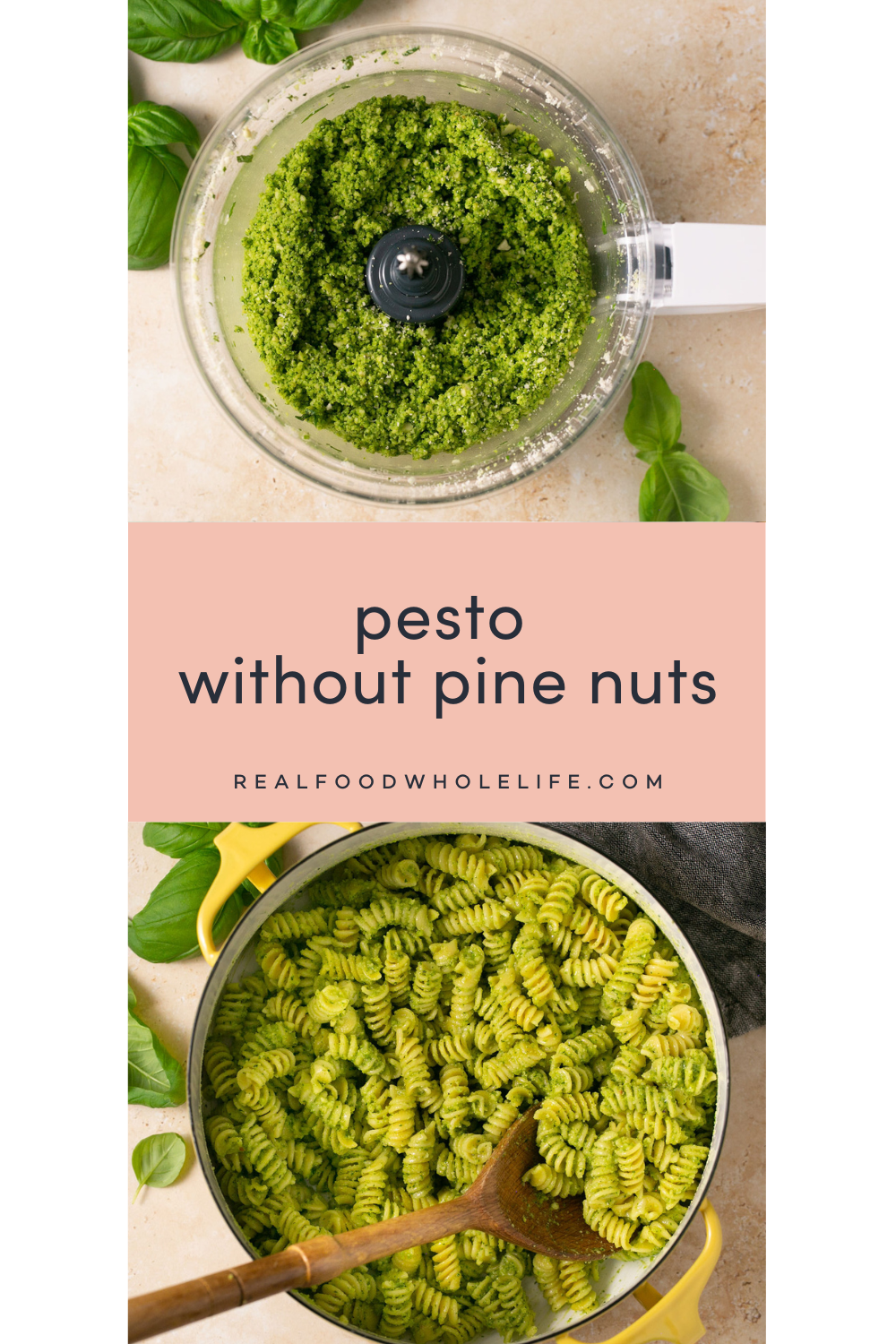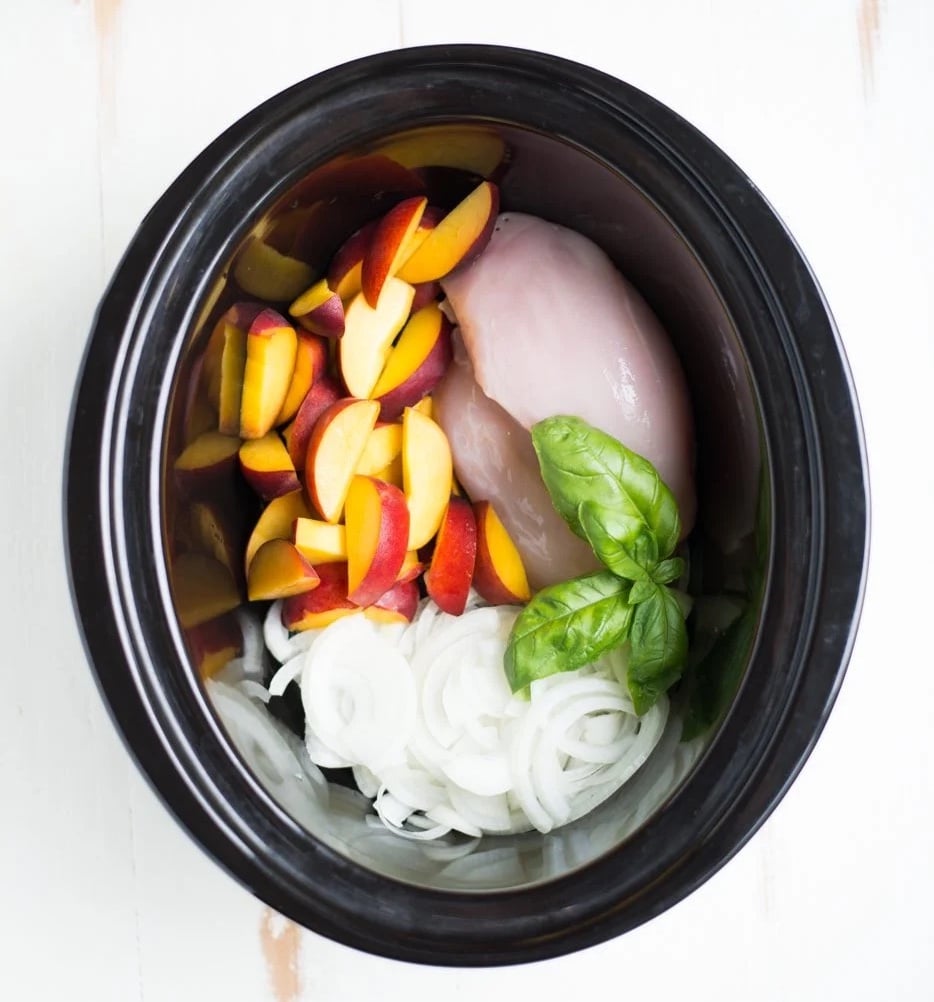5-Minute Pesto (without Pine Nuts!)
Using almonds or walnuts instead of pine nuts, this easy pesto without pine nuts recipe is a more affordable (with easier to find ingredients), and equally delicious homemade pesto! With just a few simple steps and in just 5-minutes and 5-ingredients, you can have a batch of pesto whipped up in no time.

No Pine Nuts? No Problem with this Easy Basil Pesto!
Can I fill you in on one of my favorite time-saving kitchen hacks as a habits expert? Having an arsenal of easy sauces and dressings that you can whip up in no time will elevate any meal or dish. Even if you can’t cook a full meal, adding at least one homemade element is a sure-fire way to enhance a store-bought item like rotisserie chicken or pasta. Because of this, I always keep pesto on hand as it’s one of my go-to sauces – it’s such a versatile sauce and packs a flavorful punch.
However, traditional basil pesto is made with pine nuts, which can be a bit pricey and hard to find. So, I created an equally delicious basil pesto recipe that uses blanched almonds instead of pine nuts and other ingredients you probably already have in your pantry. In no time, you’ll have a delicious pesto ready to spread on sandwiches, mix with pasta, use as a dip for veggies, or use it in this 3-ingredient pesto vinaigrette, which just happens to be my favorite was to dress this super easy tortellini pasta salad.
Welcome to My Kitchen! Let’s Make Pesto without Pine Nuts





Key Ingredients & Substitution Suggestions
- Garlic: I recommend using whole garlic cloves versus pre-minced garlic as I found the flavor to be a lot better in testing. I do not recommend granulated garlic.
- Fresh basil: Fresh basil is essential in this recipe. If you’d rather use sun dried tomatoes, check out my easy red pesto sauce.
- Blanched almonds: Blanched almonds are almonds with their skins removed, and they have a sweet flavor similar to pine nuts, but are much easier to find. Roasted almonds with skins can be used, but the sauce will be a bit more brown. You can also use walnuts, or pumpkin seeds, or sunflower seeds for a nut-free option.
- Parmesan: Try to use freshly grated parmesan if you can, though I’ve found Pecorino Romano to be a good substitute.
- Extra virgin olive oil: I highly recommend using extra virgin olive oil since the olive oil is a pronounced flavor in this recipe.

A Few of My Favorite Ways to Use Homemade Pesto
When it comes to serving this pesto without pine nuts, the possibilities are endless, hence why it’s one of my favorite sauces to have on hand. Of course, I love to mix it with some cooked pasta (hello tuna pesto pasta!), however, pesto isn’t limited to pasta. Spread it on a slice of bread and top it with mozzarella cheese and tomato for a quick and tasty lunch, use as a dip for grilled bread or vegetables, or take the flavor to the next level by using it as a pesto chicken marinade.

Follow my step-by-step video:

5-Minute Pesto without Pine Nuts
Ingredients
- 3 cloves garlic
- 2 cups fresh basil leaves, packed
- ½ cup blanched almonds, or walnuts, roughly chopped
- ½ cup freshly grated parmesan cheese
- ¼ teaspoon kosher salt, or more to taste
- ⅛ teaspoon freshly ground black pepper
- ½ cup extra virgin olive oil
Equipment
Instructions
- Add the lid to the food processor, turn to high, then drop in the garlic cloves to finely mince. Remove the lid and scrape the sides.
- Add the basil leaves and pulse several times until coarsely chopped.
- Add the nuts, cheese, salt, and pepper, and pulse until just combined. Scrape down the sides.
- Turn the food processor to low, then slowly stream in the olive oil until just combined.
- Taste and add additional salt if desired.
Notes
- See blog post, above, for substitution suggestions and my favorite ways to use homemade pesto.



Can I use a blender? I don’t have a food processor. Thanks Ev
Yes, you can use a blender, but you’ll likely need to pulse on low and stop very frequently to scrape the sides down toward the blades to there’s enough substance to actually blend. Then just be careful not to over-blend (you want a little bit of texture, so not completely smooth), which you can achieve again by pulsing rather than just blending on high. Hope you enjoy!
The addition of the nuts are missing in the recipe directions.
Just an FYI. :o)
Tamela, thanks for the catch! I’ve updated the instructions to include the nuts. I hope you enjoy this recipe!
I know summer is over when I put the last batch of this pesto in the freezer! So forgiving too…no almonds on hand? Use pepitas or any other nut instead. Not enough basil on hand? Add kale, arugula, or even carrot tops/beet greens!
Michele, love that! Here’s to versatile recipes! Thanks so much for taking the time to share your thoughts.
Just made a batch!! Yay
Just a note – use chopped nuts or at least chop them before adding to the processor.
So glad you enjoyed, Tanya, and thanks for your notes!
Lovely recipe- just made it, thanks Robyn! I’ll freeze it too.
Gemma, so happy to hear you enjoyed this one — and you’re right, this one is perfect for freezing!
First time ever making pesto, so easy why’d I wait so long came out awesome 👍
Diane, I’m so glad you discovered how easy homemade pesto can be! Thanks so much for sharing your thoughts.